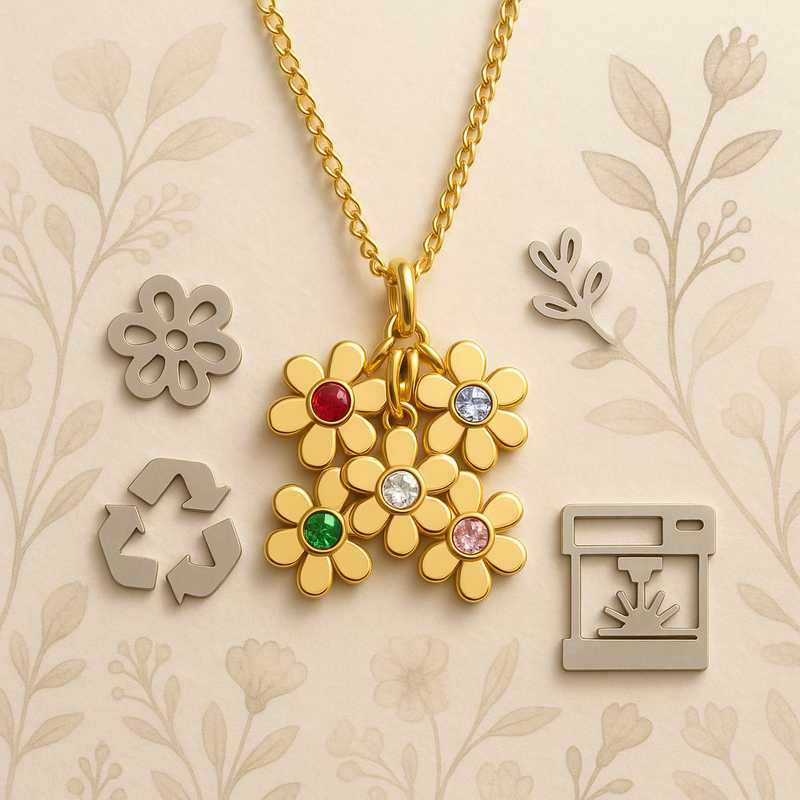Innovative Charm Crafting: The Science Behind Custom Birth Month Necklaces

Dive into cutting-edge materials and tech, exploring corrosion resistance, laser cutting, and sustainable manufacturing in custom jewelry production.
In today’s competitive jewelry market, B2B buyers are no longer satisfied with aesthetic value alone—they seek technological innovation, durability, and sustainability. Custom birth month charm necklaces, combining the sentimental value of birth flowers and gemstones with premium gold finishes, are becoming increasingly popular in both retail and wholesale markets. But what makes these necklaces stand out beyond their visual appeal? The secret lies in the meticulous selection of materials and advanced manufacturing techniques.
This article explores how manufacturers can leverage high-grade stainless steels like 304 and 316L, embrace cutting-edge techniques such as laser cutting and hydraulic forming, and implement green practices including eco-friendly electroplating and waste recycling to meet modern standards. Whether you’re an OEM/ODM provider or a procurement specialist seeking premium solutions, understanding the science behind custom jewelry can redefine your sourcing strategy.
Material Mastery: Comparing 304 vs. 316L Stainless Steel in Jewelry Applications
Stainless steel is a cornerstone material in modern charm necklace manufacturing due to its strength, corrosion resistance, and hypoallergenic qualities. Among the most commonly used grades are 304 and 316L stainless steel. While both are suitable for jewelry, their specific properties dictate their ideal application scenarios.
304 Stainless Steel: Versatile and Cost-Effective
304 stainless steel is widely used due to its affordability and good corrosion resistance. It’s a solid choice for indoor or low-moisture environments. With an 18% chromium and 8% nickel composition, it provides reasonable durability and a lustrous finish after polishing or gold PVD coating. It’s well-suited for fashion-oriented jewelry lines where price sensitivity is key.
316L Stainless Steel: The Industry Standard for Premium Jewelry
316L, known as “surgical steel,” contains 2-3% molybdenum, enhancing its resistance to chlorides and salty environments. This makes it ideal for high-end birthstone charm necklaces meant to be worn daily, even in humid climates or during physical activity. 316L’s superior resistance to tarnish and wear ensures long-lasting shine and hypoallergenic safety.
Case Example: A marine-inspired jewelry brand in Australia uses 316L exclusively for necklaces to combat saltwater corrosion and skin irritation issues reported with 304. This choice has resulted in fewer returns and a higher customer satisfaction rate.
Precision in Design: Leveraging Laser Cutting and Hydraulic Forming for Custom Charms
Advanced manufacturing methods are redefining what’s possible in small-batch and personalized jewelry production. Two technologies leading this transformation are laser cutting and hydraulic forming.
Laser Cutting for Ultra-Fine Detailing
Laser cutting offers micron-level precision for intricate flower outlines, birth month engraving, and gemstone seat placements. It ensures clean edges, minimal waste, and consistent results across bulk production. Custom logos, pattern engraving, and layered charm designs are made more accessible and cost-efficient using this method.
Example: An ODM jewelry manufacturer in South Korea reduced mold dependency by 60% after shifting to fiber laser systems, achieving higher customization at scale.
Hydraulic Forming for Complex, Multi-Dimensional Forms
Hydraulic presses enable seamless shaping of stainless steel into convex or contoured flower charms. They support uniform pressure distribution, maintaining metal grain structure and reducing cracks or deformities. This technique is especially useful for 3D bouquet effects in multi-charm necklace configurations.
Surface Innovation: Decorative Corrosion and Custom Patterning
Corrosion is typically viewed as a threat to metal integrity, but controlled corrosion—when used creatively—can serve as an artistic technique. Selective corrosion, or “corrosion patterning,” can be used to create unique textures or matte-etched finishes on stainless steel charms.
By using resist masks and chemical etchants, artisans can control the corrosion rate, crafting antique-style flower petals or textured backplates for added depth and grip. This approach blends aesthetics with tactile value, giving necklaces an artisan, handcrafted appeal while maintaining metal purity and strength.
Pro Tip: This technique can also serve to create unique SKU identifiers directly on the charm’s backside, allowing for traceability without affecting design.
Eco-Smart Manufacturing: From Green Electroplating to Material Recycling
With rising environmental regulations and conscious consumers, sustainable jewelry production is no longer optional—it’s expected. Fortunately, innovations in eco-processing allow manufacturers to meet these demands without sacrificing quality.
Green Electroplating: Gold with a Conscience
Traditional electroplating methods often involve cyanide-based solutions. Modern alternatives use non-toxic, trivalent gold baths and closed-loop water filtration systems. These reduce both worker exposure risks and environmental contamination. PVD (Physical Vapor Deposition) gold coating, another alternative, offers a durable and eco-friendly finish with less chemical waste.
Scrap Recycling and Closed-Loop Systems
Many stainless steel manufacturers now implement scrap recycling lines that recover trimming waste, offcuts, and even polishing residues. These materials are re-smelted and reintegrated into new batches, minimizing raw material dependence and reducing costs.
OEM Case Study: A Vietnam-based jewelry factory reports a 28% drop in annual raw stainless steel procurement after adopting a closed-loop recycling system, improving both margins and ESG (Environmental, Social, and Governance) scores.
Conclusion: Elevate Your Jewelry Line with Tech-Driven Craftsmanship
The future of custom birth month charm necklaces lies in more than just personalization—it thrives on technological excellence, sustainable practices, and material science. Whether choosing 316L stainless steel for longevity or leveraging laser cutting for unique bouquet arrangements, every decision shapes product quality and brand value.
For B2B buyers and OEM/ODM partners, understanding the interplay of these technologies enables smarter procurement, stronger market differentiation, and better alignment with modern consumer values.
Ready to bring innovation into your next jewelry collection? Partner with a manufacturer that integrates sustainability, precision, and premium materials from concept to final charm. Explore our OEM services or request a sample today.
